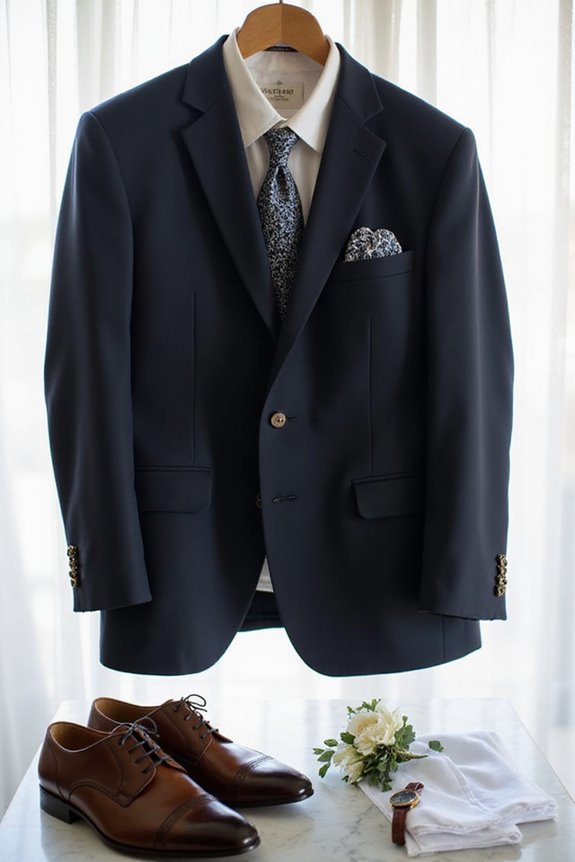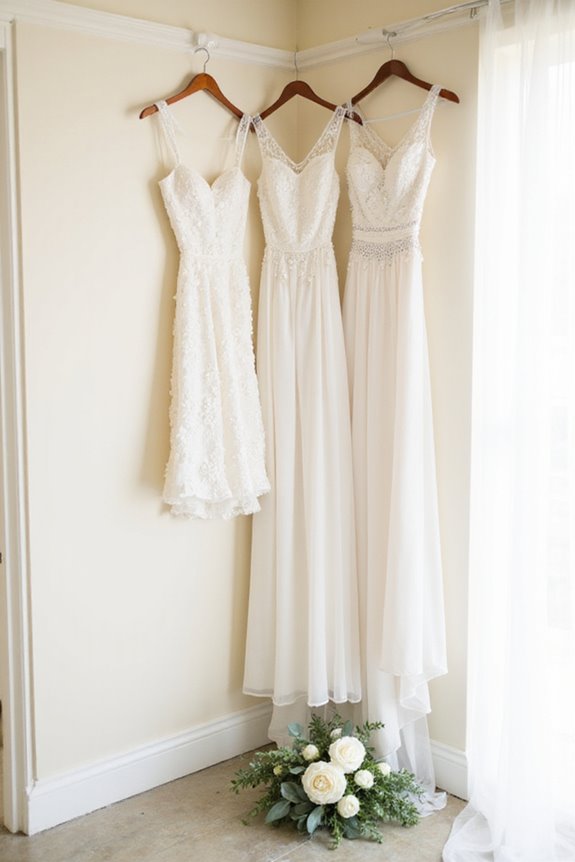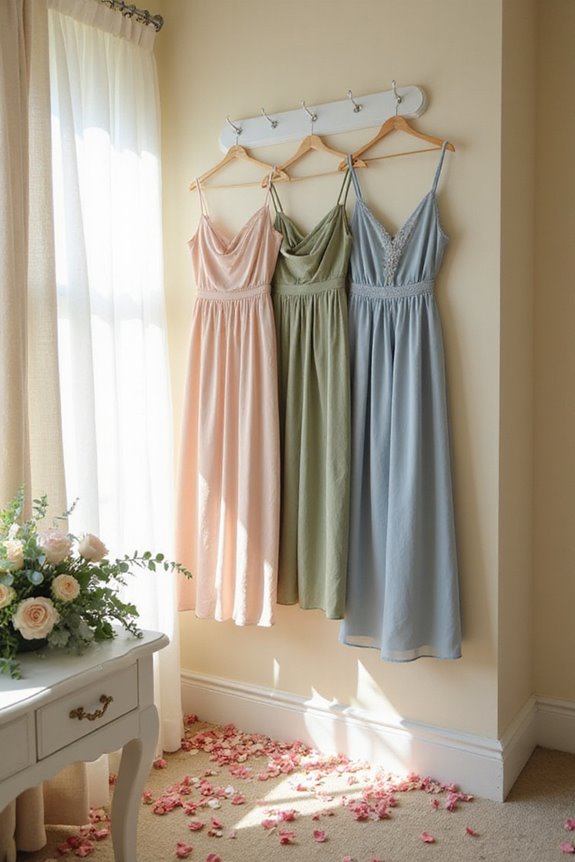Selecting the groom’s wedding attire is all about style, fit, and coordination. First, understand the event’s formality—think black-tie or semi-formal. Next, get accurate measurements to avoid that awkward baggy look. Choosing colors? Timeless options like navy work wonders, but lighter shades shine at spring weddings. And don’t forget accessories like cufflinks and polished shoes! Whether renting or buying, each has its perks. Trust us, there’s more to explore to make this easier!
Key Takeaways
- Determine the wedding’s formality level to select appropriate attire, such as tuxedos for black-tie events or suits for semi-formal occasions.
- Take accurate measurements of chest, waist, and arm length to ensure a well-fitted outfit that enhances confidence and comfort.
- Choose timeless colors like navy or charcoal gray, or lighter shades for summer, aligning with the overall wedding theme.
- Consider essential accessories like shoes, cufflinks, and ties to personalize the groom’s look and add sophistication.
- Decide between renting or buying attire based on budget and future use, weighing the benefits of customization versus cost-effectiveness.
Understanding Attire Types and Formality Levels
When it comes to choosing the groom’s wedding attire, we should think about the different types and levels of formality that can set the tone for the big day. For a black-tie affair, tuxedo styles are the way to go. They typically include a dinner jacket, trousers, and a bow tie, which really adds that touch of elegance. If we’re feeling adventurous, we can mix it up with colorful bow ties or cummerbunds. For a semi-formal vibe, a well-fitted suit can work wonders too, allowing us to keep it classy yet comfortable. Remember, the goal is to match our attire to the wedding’s formality while feeling confident and stylish. After all, no one wants to be the underdressed groom!
Importance of Fit and Measurements
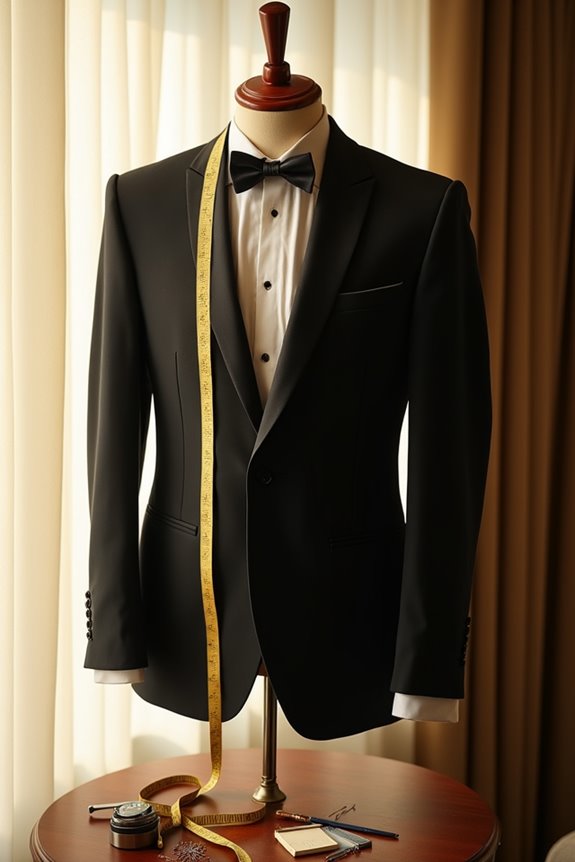
Getting the fit just right is essential for the groom’s wedding attire. A thorough fit assessment is key. We should start with accurate measurements, especially of the chest, waist, and arm length. These details prevent that dreaded baggy look or, worse, squeezing into something too tight.
Consider getting professionally measured; it’s a game changer! Tailors can help with those tricky adjustments, ensuring we look sharp without feeling restricted. Remember to wear the right undergarments during measurements for the best accuracy.
It’s wise to schedule fitting appointments a few weeks ahead to allow for any tweaks. Trust us, a well-fitted outfit not only boosts confidence but also looks fantastic in photos. Additionally, choosing higher-quality fabrics can enhance the overall appearance and comfort of the suit. Let’s make sure we nail that perfect fit!
Choosing the Right Color and Fabric
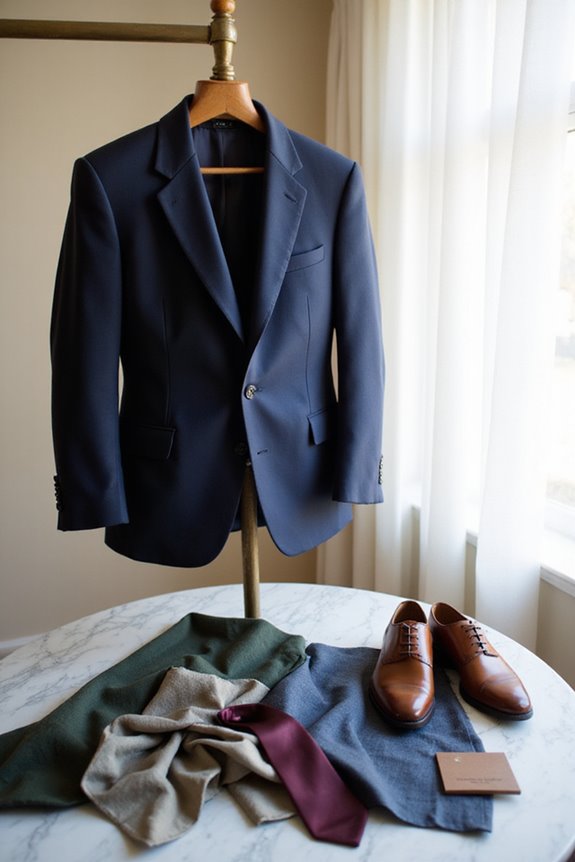
Choosing the right color and fabric for your wedding attire can feel a bit overwhelming, especially with so many options out there. Let’s explore color psychology and seasonal trends to help us out!
For timeless vibes, black, navy, or charcoal gray suits are perfect. They scream sophistication! If you’re feeling bold, opt for spring and summer colors like light blues or even cranberry. Remember, lighter fabrics work well in warm weather, while darker ones fit the cooler months.
When picking colors, think about how they fit into the overall wedding theme. Don’t forget to check colors in person—screens can be deceiving! By matching your attire to the season and theme, we’ll guarantee you shine on your big day!
Essential Accessories for the Groom
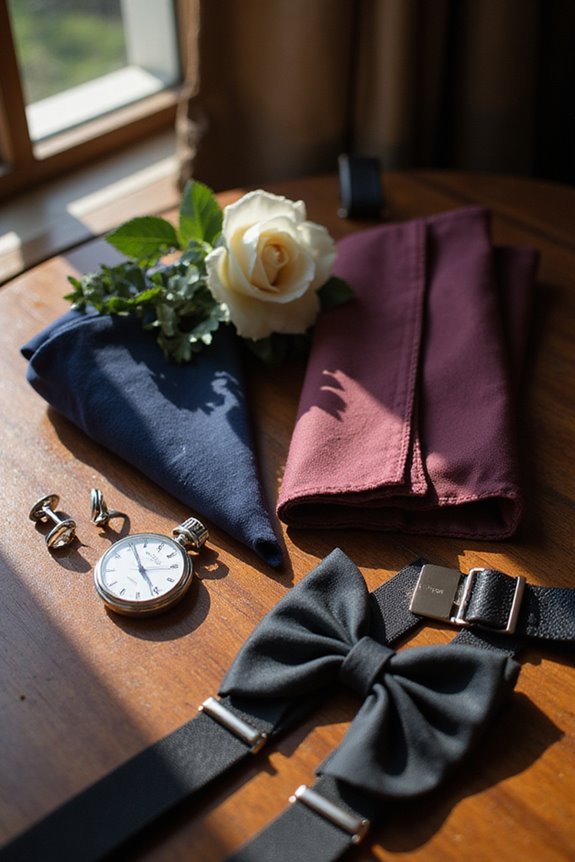
With the right color and fabric in mind, let’s talk about the accessories that can take your wedding attire to the next level. First, let’s not forget the basics: a polished pair of shoes and coordinating socks are key. They create a cohesive look. Now, let’s add some flair with cufflinks and a pocket square. These little touches allow for great personalization options.
Don’t overlook the necktie or bow tie; they’re essential for setting the tone. And hey, if you’re feeling adventurous, suspenders can really up the style game! Finally, a classy watch and a boutonniere can tie everything together. Remember, groom accessories should reflect your personality while ensuring you look sharp on your big day! Additionally, selecting the right wedding heels for comfort can enhance your overall look and ensure you feel good throughout the celebration.
Renting Vs Buying Wedding Attire
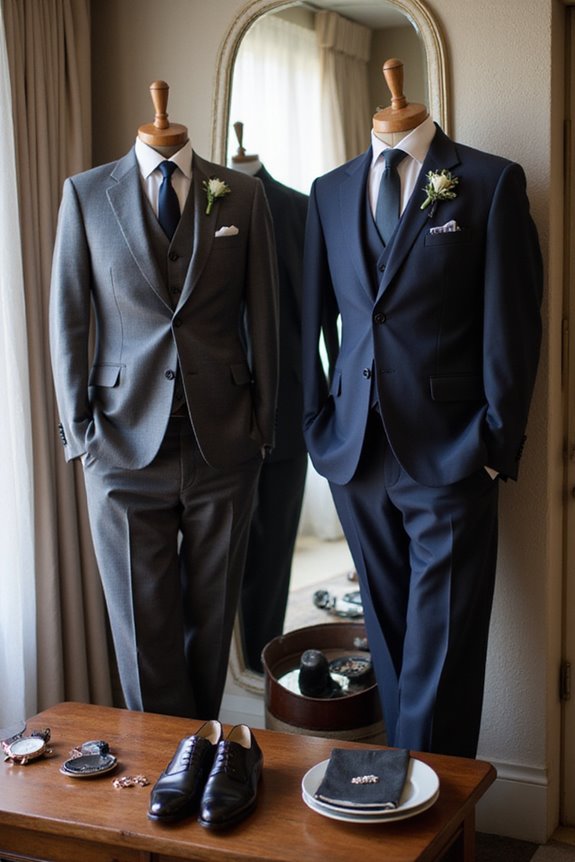
When it comes to deciding between renting or buying wedding attire, it is understood it can feel a bit overwhelming. Let’s break it down.
Rental Benefits
Renting can be a smart choice if you’re only attending one event. For around $150 to $190, you get a tuxedo without worrying about cleaning or storage. It’s hassle-free!
Ownership Advantages
On the flip side, if you’ll wear a tux often, buying is the way to go. Sure, it starts at $300, but over time, it’s cheaper—think six events! Plus, you can customize the fit and style to suit your personality.
Ultimately, we need to take into account our unique situations. Renting is convenient, but owning offers long-term savings and style—it’s a win-win!
Coordination With Wedding Theme and Partner
Finding the perfect wedding attire can feel like trying to solve a puzzle, especially when we want to coordinate with our partner and the overall wedding theme. To start, we should match our suit’s formality with the wedding style—think black-tie for formal, or linen for beachy vibes. It’s essential to avoid matching exactly with the bride’s dress, but complementing her style with accents can speak volumes. Seasonal influences also play a role; pastel tones work wonders for spring weddings, while rich fabrics like velvet create a luxurious winter feel. Remember, our attire symbolism reflects our unity. Little details, like a tie that picks up a color from the bridal party, can tie everything together beautifully without screaming, “Look at us!” Additionally, selecting a suit that features exceptional craftsmanship and fabric quality can enhance the overall appearance and comfort on the big day.
Tips for Finalizing Your Attire Choices
Finalizing our wedding attire choices can feel a bit overwhelming, especially with so many options out there. To make this easier, let’s focus on a few key points.
Tailoring Timeline Suggestions
Start your alterations at least six weeks before the big day. This gives us time to make adjustments if needed. A final fitting a week before guarantees everything fits just right.
Attire Maintenance Tips
Choose fabrics that resist wrinkles and moisture, especially for outdoor events. Cotton blends or wrinkle-free materials can be lifesavers. Don’t forget to plan for cleaning—check if your attire needs special care post-wedding.
Finally, let’s prioritize comfort. We want to enjoy the day without constantly adjusting our outfits. After all, a happy groom makes for a happy wedding!
Frequently Asked Questions
How Do I Handle Attire for a Destination Wedding?
When handling destination attire, we should prioritize comfort and style. Let’s consider travel considerations, like lightweight fabrics and packable options, ensuring we look great while adapting to the unique atmosphere of the wedding location.
What Should I Consider for Seasonal Wedding Attire?
When considering seasonal wedding attire, we should focus on fabric choices that guarantee comfort and style. Let’s also embrace seasonal colors that reflect the occasion, enhancing our overall look while keeping comfort in mind.
Are There Specific Cultural Attire Requirements I Should Know?
As we explore cultural traditions, we see attire’s significance woven into every thread. Each style tells a story of heritage and pride, reminding us how meaningful our choices can be in honoring our backgrounds.
How Can I Include Personal Style in My Wedding Outfit?
When we think about including personal style in our wedding outfit, we should focus on a tailored fit and a cohesive color palette. Unique accessories can also enhance our individuality while maintaining a unified look with the wedding party.
What Steps Should I Take if My Partner Disagrees on Attire?
When our partner disagrees on attire, we should employ communication techniques to understand their perspective, and use compromise strategies to find common ground, ensuring both our visions contribute to a harmonious wedding style.

